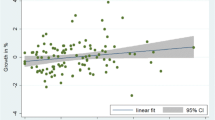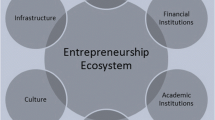Abstract
Varga, Sebestyén, Szabó and Szerb estimate the economic impact of entrepreneurship policy. Entrepreneurship policy should be added to the palette of public interventions promoting economic growth. Despite the growing evidence, the authors discuss the difficulties in measuring how a given policy intervention would affect economic growth in a particular country or region and how these effects change over time. The authors propose that these policy effects can be estimated with economic impact models, and introduce the most recent version of GMR-Europe to determine the economic repercussion of entrepreneurship-specific policy interventions. To illustrate the capacity of the model, the authors provide a detailed policy impact assessment analysis.
Access this chapter
Tax calculation will be finalised at checkout
Purchases are for personal use only
Similar content being viewed by others
Notes
- 1.
The attitude sub-index aims to identify the attitude of the people towards entrepreneurship (like the level of opportunity recognition or start-up skills within the population). Abilities are principally concerned with measuring certain important characteristics of both entrepreneurs and start-ups with high growth potential (e.g., the extent to which new opportunities motivate business startups, the share of technology intensive and creative sectors in the region). The entrepreneurial aspiration sub-index refers to the distinctive, qualitative, strategy-related nature of entrepreneurial start-up activity (i.e., the degree of innovativeness and the extent to which high growth, internationalization, and good access to finance characterize entrepreneurial businesses).
- 2.
References
Acs, Z. J., Audretsch, D. B., Braunerhjelm, P., & Carlsson, B. (2009). The knowledge spillover theory of entrepreneurship. Small Business Economics, 32, 15–30.
Acs, Z. J., Autio, E., & Szerb, L. (2014). National systems of entrepreneurship: Measurement issues and policy implications. Research Policy, 43, 476–494.
Acs, Z. J., Estrin, S., Mickiewicz, T., & Szerb, L. (2018). Entrepreneurship, institutional economics, and economic growth: an ecosystem perspective. Small Business Economics, 51(2), 501–514.
Alvedalen, J., & Boschma, R. (2017). A critical review of entrepreneurial ecosystems research: towards a future research agenda. European Planning Studies, 25, 887–903.
Anselin, L., Varga, A., & Acs, Z. J. (1997). Local geographic spillovers between university research and high technology innovations. Journal of Urban Economics, 42(3), 422–448.
Audretsch, D. B., & Belitski, M. (2017). Entrepreneurial ecosystems in cities: establishing the framework conditions. The Journal of Technology Transfer, 42, 1030–1051.
Autio, E., Pathak, S., & Wennberg, K. (2013). Consequences of cultural practices for entrepreneurial behaviors. Journal of International Business Studies, 44(4), 334–362.
Autio, E., Nambisan, S., Thomas, L. D., & Wright, M. (2018). Digital affordances, spatial affordances, and the genesis of entrepreneurial ecosystems. Strategic Entrepreneurship Journal, 12(1), 72–95.
Bayar, A. (2007). Simulation of R & D Investment scenarios and calibration of the impact on a set of multi-country models. European Commission DG JRC Institute for Prospective Technological Studies (IPTS).
Bell-Masterson, J., & Stangler, D. (2015). Measuring an entrepreneurial ecosystem. Available at SSRN: https://doi.org/10.2139/ssrn.2580336.
Boettke, P. J., & Coyne, C. J. (2009). Context matters: Institutions and entrepreneurship. Foundations and Trends® in Entrepreneurship, 5(3), 135–209.
Bradley, J. (2006). Evaluating the impact of European Union cohesion policy in less-developed countries and regions. Regional Studies, 40, 189–199.
Cooke, P. (2016). The virtues of variety in regional innovation systems and entrepreneurial ecosystems. Journal of Open Innovation: Technology, Market, and Complexity, 2(3), 13.
ESRI. (2002). An Examination of the ex-post macroeconomic impacts of CSF 1994–1999 on Objective 1 countries and regions.
Fujita, M., Krugman, P. R., & Venables, A. J. (1999). The spatial economy: Cities, regions and international trade. Wiley Online Library.
Krugman, P. (1991). Increasing returns and economic geography. Journal of Political Economy, 99(3), 483–499.
Lafuente, E., Acs, Z. J., Sanders, M., & Szerb, L. (2020). The global technology frontier: productivity growth and the relevance of Kirznerian and Schumpeterian entrepreneurship. Small Business Economics, 55(1), 153–178.
Lafuente, E., Szerb, L., & Acs, Z. J. (2016). Country level efficiency and national systems of entrepreneurship: a data envelopment analysis approach. Journal of Technology Transfer, 41(6), 1260–1283.
Isenberg, D. J. (2010). How to start an entrepreneurial revolution. Harvard Business Review, 88(6), 40–50.
Malecki, E. J. (2018). Entrepreneurship and entrepreneurial ecosystems. Geography Compass. Online access, p. 1–21. https://doi.org/10.1111/gec3.12359
Mason, C., & Brown, R. (2014). Entrepreneurial ecosystems and growth oriented entrepreneurship. Final Report to OECD, Paris, 30(1), 77–102.
Nicotra, M., Romano, M., Del Giudice, M., & Schillaci, C. E. (2018). The causal relation between entrepreneurial ecosystem and productive entrepreneurship: A measurement framework. The Journal of Technology Transfer, 43, 640–673.
Prieger, J. E., Bampoky, C., Blanco, L. R., & Liu, A. (2016). Economic growth and the optimal level of entrepreneurship. World Development, 82, 95–109.
Qian, H., Acs, Z. J., & Stough, R. R. (2013). Regional systems of entrepreneurship: the nexus of human capital, knowledge and new firm formation. Journal of Economic Geography, 13, 559–587.
Ratto, M., Roeger, W., & in’t Veld, J. (2009). QUEST III: An estimated open-economy DSGE model of the euro area with fiscal and monetary policy. Economic Modelling, 26, 222–233.
Romer, P. M. (1990). Endogenous technological change. Journal of Political Economy, 98, S71–S102.
Roundy, P. T., Bradshaw, M., & Brockman, B. K. (2018). The emergence of entrepreneurial ecosystems: A complex adaptive systems approach. Journal of Business Research, 86, 1–10.
Schalk, H., & Varga, A. (2004). The economic effects of EU community support framework interventions. An Ex-ante Impact Analysis With EcoRET, A Macroeconomic Model For Hungary. Center of Applied Economic Research Münster (CAWM), University of Münster.
Spigel, B. (2017). The relational organization of entrepreneurial ecosystems. Entrepreneurship Theory and Practice, 41(1), 49–72.
Stam, E. (2015). Entrepreneurial ecosystems and regional policy: a sympathetic critique. European Planning Studies, 23, 1759–1769.
Stam, E. (2018). Measuring entrepreneurial ecosystems. Entrepreneurial ecosystems: Place-based transformations and transitions, 173–197.
Startup Genome. (2019). Global startup ecosystem report 2019. Available at https://startupgenome.com/reports/global-startup-ecosystem-report-2019
Suresh, J., & Ramraj, R. (2012). Entrepreneurial ecosystem: Case study on the influence of environmental factors on entrepreneurial success. European Journal of Business and Management, 4(16), 95–101.
Szerb, L., Lafuente, E., Horváth, K., & Páger, B. (2019). The relevance of quantity and quality entrepreneurship for regional performance: The moderating role of the entrepreneurial ecosystem. Regional Studies, 53(9), 1308–1320.
Szerb, L., Vörös, Z., Komlósi, É., Acs, Z. J., Páger, B., & Rappai, G. (2017). The regional entrepreneurship and development index: structure, data, methodology and policy applications. Fires Report D, 4.
Ter Wal, A. L., Criscuolo, P., McEvily, B., & Salter, A. (2018, July). The relative value of the division versus duplication of network ties for innovation performance. In Academy of Management Proceedings (Vol. 2018, No. 1, p. 14225). Briarcliff Manor, NY 10510: Academy of Management.
Treyz, G., Rickman, D., & Shao, G. (1992). The REMI economic-demographic forecasting and simulation model. International Regional Science Review, 14, 221–253.
Ucbasaran, D., Westhead, P., & Wright, M. (2001). The focus of entrepreneurial research: contextual and process issues. Entrepreneurship theory and practice, 25(4), 57–80.
Varga, A. (2000). Local academic knowledge transfers and the concentration of economic activity. Journal of Regional Science, 40(2), 289–309.
Varga, A. (2006). The spatial dimension of innovation and growth: empirical research methodology and policy analysis. European Planning Studies, 14(9), 1171–1186.
Varga, A. (2007). GMR-Hungary: A complex macro-regional model for the analysis of development policy impacts on the Hungarian economy. PTE KTK KRTI Working Papers(2007/4).
Varga, A. (2017). Place-based, spatially blind, or both? challenges in estimating the impacts of modern development policies: The case of the GMR policy impact modeling approach. International Regional Science Review, 40, 12–37.
Varga, A., & Baypinar, M. (2016). Economic impact assessment of alternative European Neighborhood Policy (ENP) options with the application of the GMR-Turkey model. The Annals of Regional Science, 56, 153–176.
Varga, A., Járosi, P., & Sebestyén, T. (2011). Modeling the economic impacts of regional R & D subsidies: The GMR-Europe model and its application for EU Framework Program policy impact simulations. Paper presented at the 6th International Seminar on Regional Innovation Policies, University of Lund, Lund, Sweden.
Varga, A., Járosi, P., Sebestyén, T., & Baypinar M. B. (2013). Detailed policy impact model SEARCH deliverable 6.2.
Varga, A., Járosi, P., Sebestyén, T., & Szerb, L. (2015). Extension and application of the GMR-Eurozone model towards the CEE regions for impact assessment of smart specialisation policies. GRINCOH Working Papers. https://doi.org/10.13140/RG.2.1.5152.6567
Varga, A., Sebestyén, T., Szabó, N., & Szerb, L. (2018). Economic impact assessment of entrepreneurship policies with the GMR-Europe Model. FIRES project report D4.6, 2018.04.06.
Welter, F., & Gartner, W. (2016). A research agenda for entrepreneurship and context. Edward Elgar Publishing. https://doi.org/10.4337/9781784716844
Zahra, S. A. (2007). Contextualizing theory building in entrepreneurship research. Journal of Business Venturing, 22(3), 443–452.
Author information
Authors and Affiliations
Corresponding author
Editor information
Editors and Affiliations
Rights and permissions
Copyright information
© 2023 The Author(s), under exclusive license to Springer Nature Switzerland AG
About this chapter
Cite this chapter
Varga, A., Sebestyén, T., Szabó, N., Szerb, L. (2023). Measuring the Effects of Policies Targeting Entrepreneurial Ecosystems: An Application of the GMR Framework with REDI. In: Acs, Z.J., Lafuente, E., Szerb, L. (eds) The Entrepreneurial Ecosystem. Palgrave Studies in Entrepreneurship and Society. Palgrave Macmillan, Cham. https://doi.org/10.1007/978-3-031-25931-9_7
Download citation
DOI: https://doi.org/10.1007/978-3-031-25931-9_7
Published:
Publisher Name: Palgrave Macmillan, Cham
Print ISBN: 978-3-031-25930-2
Online ISBN: 978-3-031-25931-9
eBook Packages: Business and ManagementBusiness and Management (R0)




